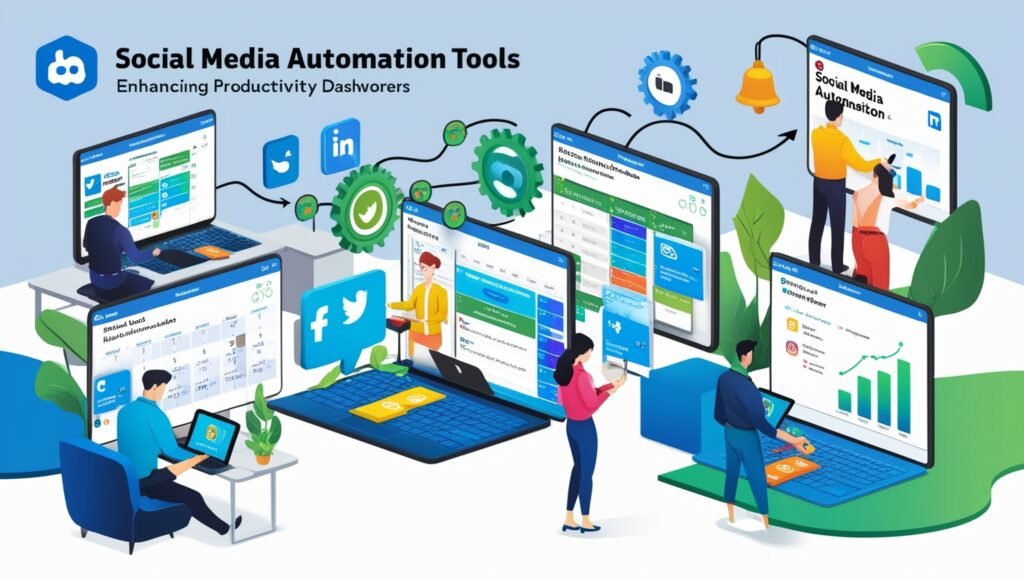As of now, today‘s professionals use task automation tools to boost productivity to manage their work more effectively. Technology has made fast strides around making task automation tools in order to streamline workflows and up the overall productivity among the staff. It enables automating repetitive tasks that consume the majority of employees’ time and lets them focus more on strategic value-added work streams. Task automation is something that has the potential to revolutionize your entire workflow, saving you time in everything you do-from project management to email marketing.
Thus, the article focuses on what task automation tools are, their different forms, and how harnessing them can propel productivity significantly. It will also give tips on which of the tools out there works best for your needs. Finally, it will dig into how automation has a role to play in either personal or professional success.
What Are Task Automation Tools?
An automated task, at its base, is a software and technology application that performs routine activities without human intervention. Task automation tools to boost productivity can perform everything from sending emails and posting on social networks to managing data entry and organizing timelines. These tools seek to simplify operations and help individual carry out their tasks faster with fewer errors.
For instance, if you run a business, regularly sending emails to your customers could be an absolute nightmare. Instead of crafting a new message for every individual, for example, in this case, suppose you use a tool like Mailchimp that helps email automation, which enables you to create email templates and schedule messages to be automatically sent at a later time. The result is timely communications that do not require constant monitoring.
From marketing to IT, accounting and customer service, and so many other industries, you can apply these kinds of tools. Indeed, their flexibility makes them beneficial for any type of company-from small businesses to multinationals. It is a computationally efficient way of working and increasing productivity; it must also be the most realistic way to keep a company competitive in such a fast-moving marketplace.
Why Task Automation Tools to Boost Productivity are Essential

Productivity is only one multipart element that would pave a way to an accomplished business or person. The most productive in the shortest time can accomplish more and go further than someone who is not so productive. Efficiency in personal tasks is essential for improving productivity, and there is where task automation tools to boost productivity come into play.
- Time Savings: Saving time is amongst the benefits of task automation. When repetitive tasks are automated, it means they are no longer performed manually. Time saved can be redirected into more strategic, creative, or business-critical work rather than time-consuming manual work. For example, automating data entry or report generation means that employees can focus on analyzing data instead of spending hours compiling it.
- Error Reduction: Manual work often leaves much room for errors that cost time and money in correction. Therefore, task automation systems consistently perform the work as programmed and tend to eliminate any possibility of human error. For instance, an automated invoice system generates and sends invoices with perfect accuracy every time in order to reduce the possibility of mistakes.
- Better Workflow: Automating tasks is very crucial for establishing a seamless workflow whereby you set up automated processes that run tasks automatically. This will help internalize the organization and also cut bottlenecks thus potentially improving overall productivity for the team. For example, with automation tools such as Asana or Trello, team members can complete project tasks with tracking for progress, assigning tasks, and setting deadlines without micromanagement.
- Increased Ability: More tasks translate to increased productivity due to the elimination of small-scale, less-valuable tasks in your to-do list to create time for high-priority objectives. Productivity can improve tremendously, such that even automation tools can manage hundreds of ongoing tasks simultaneously, thus increasing your overall ability to complete work.
Types of Task Automation Tools to Boost Productivity
Having established the role of task automation, let’s look at the most common forms of automation tools and how using them will enhance productivity. Each tool is designed for a particular action-from project management to marketing campaigns, through customer support, to IT support.
1. Project Management Automation Tools
Project management itself is all concerned about bringing together various tasks, timelines, and people together to do a specific job. There are project management tools like Trello, Asana, and Monday.com to help teams manage work task assignments, set deadlines, and allocate responsibilities. Such platforms also come with features to automatically remind, progress update, and notify, thus keeping everyone at one pace.
To illustrate, there can be a workflow in which every team member gets alerted whenever a specific task is completed. You can create an automated reminder to alert the team members nearing their deadlines. This makes a decrease in passing through those constant follow-ups and always be remembered.
When such tedious-looking project management tasks get transformed into automation, they might soon have enabled a significant productivity enhancement, reduced delays, and assured hold on project progress.
2. Email Marketing Automation Tools
And one such medium is email marketing, which is most effective in connecting customers and generating leads. However, it can be time-consuming to manage an email campaign manually. Features like set email sequences such as a welcome email, a newsletter, or promotions, can be run from the email marketing automation tools like Mailchimp, Constant Contact, and HubSpot. Mailchimp gives businesses the opportunity to segment their audience, schedule email campaigns, and track performance, all without any manual inputs.
Such tools would thus help users segment their email lists, automate scheduling, and track the effectiveness of each campaign without the need to send every mail manually. Take an example, let’s say an e-commerce store; using such a tool, it could set up automated abandoned cart emails to remind customers to finalize their purchases-the result: an increased conversion rate and more efficient productivity as customers come back by themselves.
Finally, having saved a great deal of time, such email automation tools tell one what his customers are doing, in turn raising the chances for optimizing future campaigns for better results.
3. Social Media Automation Tools
But managing networks at various locations could be a hassle, especially considering the constant posting from one social source to another. Social media automation tools such as Buffer, Hootsuite from the idea behind these created by Sprout Social have been really helpful, as they allow specific users to schedule posts in advance for streamlining the process of managing multiple accounts from a single dashboard.

In other words, when the content goes online, it can be very effective, without you needing to be in front of your desktop. You can also track engagement metrics, respond to comments, and analyze the performance of your posts via automated report generation. Social media automation tools allow you to interact with your audience without the hassle of posting updates every time.
It allows even businesses that cannot have much time to spend on the social media platforms to keep active, interact with their audience, and have broader reaches automatically. Reduction in man’s input has, however, increased productivity in the digital setting.
4. Workflow Automation Tools
Creating an automated process to move information and tasks amongst applications is workflow automation. Workflow automation tools like Zapier can connect applications and services, allowing you to automate entire repetitive tasks between different platforms. Integromat, and Microsoft Power Automate connect different applications and services, thereby automating repetitive tasks across platforms.
For example, you could automatically save every email attachment into Google Drive using Zapier, or every time a new task is entered into your project management tool, send a Slack notification. There needn’t be data entry each time; furthermore, time can be saved spent switching applications.
Workflow automation tools can indeed increase productivity, as they assure that tasks get completed on time and always as per requirement without human intervention. They are especially beneficial for teams, which carry more than one application to manage their work, in that the time lost moving data between systems is reduced.
5. Customer Support Automation Tools
Excellent customer service brings the customers back and keeps them satisfied. But, handling inquiries from customers becomes very labor-intensive and very time-consuming for many businesses. Therefore, they have to incorporate some tools of customer support automation, such as Zendesk, Freshdesk, Intercom, etc., that automate all customer interactions through chatbots, automated ticket systems, and self-service options.
For example, a chatbot is programmed to handle frequently asked questions or direct such inquiries to departments where they would be dealt with. Thus, relieving customer support agents of some workloads. Automated ticketing systems ensure that the issues customers complain about are logged, tracked, and resolved within an appropriate time.

If such tools are deployed, it helps organizations to increase productivity in customer service departments with shorter response times. This results in happier customers who show increased loyalty.
How to Choose the Right Task Automation Tool
The choice of the correct task automation tools is determined by the needs of a user and the tasks he wants to automate. A few of these parameters can help in deciding the most suitable tool for your business or yourself:
- Identify Your Needs: First, analyze the functions you spend most of your time doing in your daily workflow. Are you really busy with email or social media management or too much project tasking? When you figure out the need for automation, you can start searching for tools that can take care of that.
- Integration Ease: You will have to ensure that the tool integrates seamlessly with other applications and platforms you have at your disposal. Most of the task automation tools allow pre-built integrations of popular apps like Google Drive, Slack, Salesforce, etc. But make sure the work runs with the existing tools of your organization.
- Costs: Many tools of automation today offer their service for free with limited features, while the rest mandate that you subscribe for their extra features. Budgetary factors should guide the choice of an appropriate tool, for features offered will directly match those in use for your automation requirements.
- Ease of Use: Look for tools that have intuitive user interfaces with readily understandable instructions. A tool that is difficult to navigate or set up would harm productivity rather than enhance it.
In considering these things, you will have the best task automation tool for your needs and dramatically increase productivity.
Conclusion
Task automation tools to boost productivity are not merely a trend anymore, but rather an indispensable part of the workflow in today’s hectic workplace environment. Be it an automated email campaign, social media posts, project management, or customer support. There is a tool for each goal of automation you may want to consider.
At one and the same time, you can do most of your repetitive tasks while taking care of the most strategic, high-level functions involving your expertise and leaving most of the grunt processing task in the background. This will make your workflow more fluid, raise levels of productivity among your teams, and translation will be to higher efficiency in the overall system.
Choose wisely your task automation tools and enjoy the possibility of saving time because you’ll be minimizing errors and taking productivity performance to a whole new level. The repetitive, routine tasks which automation takes care of within your working life give you time that can then be diverted into more meaningful work which, in turn, opens up avenues for personal as well as professional growth.
Read more about Remote Work Productivity Tips
Frequently Asked Questions
1. What are task automation tools to boost productivity?
These are software applications that can perform activities without a human being intervening in the process. Activities such as sending emails and entering data, or other scheduling activities would be automated, and it would assist the individual or organization with streamlining operations and reducing errors.
2. The reason why It would be task automation productivity?
Task automation saves time by taking care of repetitive tasks; reduces error through performing with consistency; improves overall flow by eliminating bottlenecks; and increases overall capacity to handle more work in an efficient manner so that the focus can shift to strategic and more valuable activities.
3. What Are the Common Types of Task Automation Tools?
Common types include:
- Project Management Tools (e.g., Trello, Asana)
- Email Marketing Tools (e.g., Mailchimp, HubSpot)
- Social Media Automation Tools (e.g., Buffer, Hootsuite)
- Workflow Automation Tools (e.g., Zapier, Microsoft Power Automate)
- Customer Support Tools (e.g., Zendesk, Freshdesk)
4. How Do You Choose the Right Task Automation Tool?
To choose the right tool:
- Identify Your Needs: Determine which tasks need automation.
- Check Integration Ease: Ensure compatibility with existing applications.
- Consider Costs: Balance features with your budget.
- Evaluate Ease of Use: Select tools with intuitive interfaces to enhance productivity.

